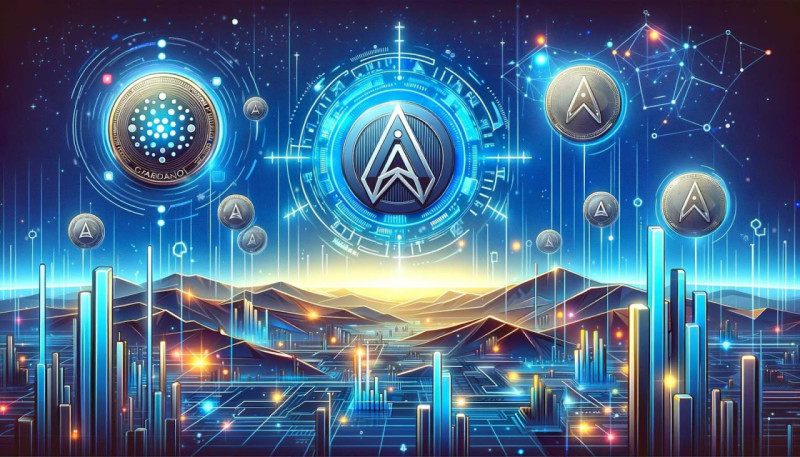
Introduction
In the digital age, the evolution of financial technology has ushered in an era of cryptocurrency, marking a revolutionary shift in the landscape of digital money. Among the diverse array of cryptocurrencies, those that stand out are often included in a utility cryptocurrency list, highlighting digital currencies that offer more than just a means of transaction. These cryptocurrencies, which operate independently of centralized financial institutions, leverage blockchain technology to gain transparency, immutability, and security. This transformative approach fundamentally changes how we perceive and interact with money. Unlike traditional currencies controlled by national governments, the decentralized nature of cryptocurrencies offers users a level of anonymity and freedom from institutional oversight that was previously unimaginable, showcasing the practical and innovative applications of these digital assets beyond mere speculation.
The concept of cryptocurrency was first brought to life with the creation of Bitcoin in 2009, a peer-to-peer electronic cash system that aimed to solve the double-spending problem without the need for a trusted authority or central server. Since then, the cryptocurrency market has exploded with thousands of unique cryptocurrencies, each designed with specific features, uses, and underlying technologies that address various needs and potential applications beyond simple transactions. Among these digital assets is ADA, the native currency of the Cardano blockchain platform, which stands out for its scientific approach to design and development, aiming to address some of the scalability, interoperability, and sustainability challenges faced by earlier cryptocurrencies.
As cryptocurrencies continue to evolve, they challenge traditional financial systems, offering new ways of thinking about and handling digital transactions. With the rise of decentralized finance (DeFi) and non-fungible tokens (NFTs), the potential applications of cryptocurrencies have expanded far beyond their initial conception, making them a fascinating and integral part of the future of finance.
Introduction to, what is ADA Crypto?
ADA is the native cryptocurrency of Cardano, a blockchain platform founded in 2015 by Ethereum co-founder Charles Hoskinson. Named after Ada Lovelace, a 19th-century mathematician recognized as the first computer programmer, ADA and its underlying platform aim to create a more balanced and sustainable ecosystem for cryptocurrencies. Unlike many of its predecessors and contemporaries, Cardano does not rely on a white paper but is developed through evidence-based methods, with its technology underpinned by peer-reviewed academic research. This rigorous approach to development seeks to ensure scalability, interoperability, and sustainability, addressing some of the critical challenges that have plagued earlier blockchain projects.
Since its launch, ADA has quickly risen to prominence in the crypto world, distinguishing itself through its commitment to scientific precision and an ethical, transparent approach to design and implementation. The Cardano network operates on a unique dual-layer architecture, separating the settlement layer that handles transactions from the computational layer that manages smart contracts and applications. This separation allows for greater flexibility and efficiency, making Cardano a potent platform for a wide range of applications, from financial transactions to secure voting systems.
Cardano's consensus mechanism, Ouroboros, is another standout feature. It is one of the first proof-of-stake (PoS) protocols proven to be secure through academic research. Ouroboros reduces the energy expenditure associated with proof-of-work (PoW) systems like Bitcoin, making ADA not only more environmentally friendly but also poised for future scalability.
In the broader crypto ecosystem, ADA occupies a unique place. It is seen as a third-generation cryptocurrency that seeks to overcome the limitations of first-generation cryptocurrencies like Bitcoin (which introduced the concept of digital currency) and second-generation cryptocurrencies like Ethereum (which expanded use cases to include smart contracts and decentralized applications). With its foundation in academic rigor, a strong commitment to sustainability, and a clear vision for future development, ADA is not just another digital currency. It is part of a broader effort to solve some of the most pressing issues facing the cryptocurrency world today, including scalability, interoperability, and sustainability.
What Is ADA Crypto: The Fundamentals
ADA cryptocurrency is the digital asset native to the Cardano blockchain platform, serving as the fuel for operations within the Cardano ecosystem. As a cryptocurrency, ADA is used for a variety of functions within the Cardano network, such as enabling users to participate in operations of the network through staking, paying for transaction fees to ensure the transfer of digital funds, and facilitating smart contracts and decentralized applications (dApps) that run on Cardano's blockchain.
Named after Ada Lovelace, a pioneering figure in computing history, ADA embodies the spirit of innovation and forward-thinking that drives the Cardano platform. It represents a new wave of digital currency that not only seeks to provide a medium of exchange but also aims to solve some of the technical challenges faced by earlier cryptocurrencies, such as scalability, interoperability, and sustainability. ADA's design and utility are rooted in the scientific philosophy that underpins the Cardano project, which emphasizes research-driven approaches and peer-reviewed insights to build a more secure, scalable, and efficient blockchain.
The ADA token is integral to the Cardano proof-of-stake (PoS) mechanism, Ouroboros, which allows token holders to participate in the network. By staking ADA, holders can vote on potential changes to the software, participate in the validation process of transactions, and earn rewards, contributing to the network's security and governance. This approach not only democratizes the process of network maintenance but also aligns with Cardano's broader goals of creating a more inclusive and sustainable global financial and social system.
As a cryptocurrency, ADA operates on a decentralized ledger and is traded on various cryptocurrency exchanges, enabling users to buy, sell, or hold the digital currency as an investment or for use within the Cardano ecosystem. With its robust technological foundation and a clear vision for addressing the needs of modern digital economies, ADA stands out as a key player in the ongoing evolution of blockchain technology and cryptocurrencies.

History and development of the Cardano platform: What Is ADA Crypto?
The history and development of ADA and the Cardano platform are rooted in a vision to improve upon the limitations of previous blockchain technologies, with a focus on scalability, interoperability, and sustainability. Launched in 2017, Cardano and its native cryptocurrency, ADA, were developed by IOHK (Input Output Hong Kong), a leading blockchain research and development company co-founded by Charles Hoskinson, one of the co-founders of Ethereum, and Jeremy Wood.
Origins
Cardano's inception was driven by the desire to create a more balanced and sustainable blockchain ecosystem. Recognizing the challenges faced by first-generation blockchains like Bitcoin and second-generation blockchains like Ethereum, including issues related to scalability, energy consumption, and the need for more robust governance models, Hoskinson set out to build a third-generation blockchain that would address these issues head-on.
Development Approach
From the outset, Cardano distinguished itself through its commitment to a science-based philosophy, relying on peer-reviewed academic research to inform its design decisions. This approach marked a departure from the more traditional development paths taken by other cryptocurrencies, ensuring that every aspect of Cardano's architecture and protocol was designed with efficiency, security, and scalability in mind.
The development of Cardano has been structured into five main phases, each focusing on specific capabilities of the blockchain:
- Byron. The initial phase, which focused on the development of the Cardano mainnet, allowing users to buy, sell, and transfer ADA tokens.
- Shelley. This phase aimed at decentralizing the network, introducing the Ouroboros proof-of-stake mechanism to increase the network's security and robustness.
- Goguen. Focused on adding smart contract functionality, allowing developers to create decentralized applications (dApps) on the Cardano blockchain.
- Basho. Aimed at improving the scalability and interoperability of the network, ensuring that Cardano can handle a growing number of transactions and interact with other blockchains.
- Voltaire. Focused on introducing a self-sustaining governance model, enabling ADA holders to vote on future development proposals and use of treasury funds.
ADA's Role
ADA plays a central role in the Cardano ecosystem, serving not only as a digital currency but also as a means for staking and governance. As Cardano progresses through its development phases, ADA's utility continues to expand, supporting a growing range of applications and services on the blockchain.
Global Impact
Beyond its technological innovations, Cardano aims to have a broader impact on the world. Its mission includes providing financial services to the unbanked and creating more transparent and secure systems for people worldwide. The platform's emphasis on sustainability, demonstrated by its energy-efficient consensus mechanism, aligns with global efforts to reduce the carbon footprint of blockchain technology.
The history and development of ADA and the Cardano platform reflect a thoughtful and methodical approach to solving the complex challenges of modern blockchain technology. Through continuous innovation and a commitment to its founding principles, Cardano seeks to pave the way for a more secure, efficient, and equitable global blockchain ecosystem.
What is ADA Crypto: The purpose and goals
The purpose and goals of ADA and the broader Cardano ecosystem are deeply intertwined, reflecting a vision for a more secure, scalable, and sustainable blockchain infrastructure. ADA, as the native cryptocurrency of Cardano, is designed not only to facilitate transactions but also to serve as a foundational element for a new financial and social operating system. Here are the key purposes and goals that drive ADA and the Cardano platform:
1. Creating a More Secure and Scalable Blockchain
Cardano's development was motivated by the desire to address the limitations of previous blockchain generations, including scalability issues and security vulnerabilities. ADA is at the heart of this effort, underpinned by the Ouroboros proof-of-stake algorithm, which aims to offer a more energy-efficient and scalable alternative to traditional proof-of-work systems.
2. Facilitating Decentralized Finance (DeFi)
One of the primary goals of ADA is to empower decentralized finance, offering an alternative to traditional financial systems that are often inaccessible to a significant portion of the global population. By enabling smart contracts and decentralized applications on Cardano, ADA can be used in lending, borrowing, and a wide range of financial services without the need for intermediaries, thereby reducing costs and increasing access.
3. Enabling a Democratic Governance Model
Cardano aims to foster a community-driven governance model, wherein ADA holders can participate in decision-making processes regarding the future development of the network. This approach aims to ensure that the platform evolves in a way that reflects the needs and desires of its users, promoting a more inclusive and sustainable ecosystem.
4. Supporting Sustainable Development
Sustainability is a core principle of Cardano, with the platform designed to be energy-efficient and environmentally friendly, addressing one of the major criticisms faced by many other cryptocurrencies. The goal is to make ADA an attractive option for users and organizations that prioritize sustainability.
5. Providing Solutions for Real-World Applications
Beyond serving as a digital currency, ADA and the Cardano platform aim to solve real-world problems through advanced blockchain technology. This includes creating more secure voting systems, improving supply chain management, and providing identity management solutions, all of which can significantly impact various sectors such as finance, healthcare, and government.
6. Bringing Financial Services to the Unbanked
A significant portion of the global population lacks access to basic financial services. Cardano aspires to change this by leveraging ADA and its blockchain technology to offer secure, accessible, and affordable financial services to those who are currently unbanked or underbanked, thereby contributing to financial inclusion on a global scale.
7. Promoting Interoperability
Cardano and ADA aim to promote interoperability among various blockchain networks, facilitating seamless exchanges and interactions. This goal reflects a broader vision for a connected and interoperable blockchain ecosystem, where different platforms can work together harmoniously.
In essence, the purpose and goals of ADA/crypto are ambitious, reflecting a comprehensive vision for leveraging blockchain technology to create a more inclusive, efficient, and sustainable world. Through its focus on scalability, security, and sustainability, Cardano seeks to pave the way for a new era of blockchain utility that extends far beyond traditional financial transactions.

What Is ADA Crypto and How It Works
Cardano's unique blockchain structure distinguishes it within the crowded field of cryptocurrency platforms, offering a novel approach to scalability, security, and sustainability. At the heart of this distinction is its layered architecture, which separates the settlement layer that handles transactions from the computational layer that deals with smart contracts and applications. This separation allows for more flexibility and scalability, enabling Cardano to process transactions efficiently while also providing a robust platform for building decentralized applications (dApps).
The Two-Layered Architecture
1. The Cardano Settlement Layer (CSL)
The first layer, known as the Cardano Settlement Layer (CSL), is where all ADA transactions occur. It's designed specifically for this purpose, ensuring that the transfer of ADA between accounts is secure, quick, and efficient. The CSL employs the Ouroboros Proof-of-Stake (PoS) consensus mechanism, which is a critical innovation in Cardano's design. Ouroboros divides time into epochs and slots, where slots are fixed periods, and epochs are collections of slots. In each slot, a slot leader is chosen to validate transactions, create a block, and add it to the blockchain. This process is designed to be energy-efficient compared to Proof-of-Work (PoW) mechanisms, aligning with Cardano's sustainability goals.
2. The Cardano Computation Layer (CCL)
The second layer, the Cardano Computation Layer (CCL), is where smart contracts and dApps operate. This layer is designed to be highly flexible, allowing developers to create contracts that can interact in complex ways without compromising the network's integrity. The CCL can be updated and modified independently of the CSL, enabling Cardano to adapt to new requirements or integrate new features without undergoing a hard fork. This adaptability is crucial for maintaining long-term sustainability and for accommodating a wide range of applications.
Advanced Features for Enhanced Functionality
- Plutus. A purpose-built smart contract development language and execution platform that provides a safer and more robust environment for the creation of dApps.
- Marlowe. A domain-specific language for financial contracts built on Cardano, designed to make the execution of smart contracts more accessible to those without deep programming knowledge.
Security and Sustainability
Security is a cornerstone of Cardano's design, with the Ouroboros consensus algorithm undergoing rigorous academic scrutiny to ensure it can withstand a variety of attacks. Sustainability is also a key focus, with Cardano aiming to minimize energy consumption through its PoS mechanism, making it an eco-friendly alternative in the blockchain space.
Interoperability and Scalability
Cardano also emphasizes interoperability and scalability, aiming to facilitate seamless transactions across different blockchains and to handle a growing volume of transactions as adoption increases. The layered architecture, combined with cutting-edge research and development efforts, positions Cardano as a highly scalable and interoperable blockchain platform.
In summary, Cardano's unique blockchain structure, characterized by its dual-layer architecture, sophisticated consensus mechanism, and commitment to security and sustainability, sets it apart as a platform designed not just for today's needs but for the future of blockchain technology.
Overview of Ouroboros Proof-of-Stake (PoS) algorithm: what is ADA Crypto
The Ouroboros Proof-of-Stake (PoS) algorithm is a fundamental component of the Cardano blockchain, representing a significant advancement in the field of blockchain consensus mechanisms. Designed with a focus on security, efficiency, and sustainability, Ouroboros distinguishes itself from other consensus mechanisms by its unique approach to validating transactions and maintaining blockchain integrity without the significant energy consumption associated with Proof-of-Work (PoW) systems like Bitcoin.
Key Features of Ouroboros
1. Proof-of-Stake Model
Unlike PoW, which requires miners to solve complex mathematical problems to validate transactions and create new blocks, PoS relies on the stake (the amount of cryptocurrency held) as the primary resource for securing the network. In Ouroboros, ADA holders who choose to participate in the network can stake their ADA as a form of collateral to become slot leaders or validators, responsible for adding new blocks to the blockchain.
2. Epochs and Slots
Ouroboros divides time into epochs, which are further divided into slots. A slot is a fixed period, and each epoch consists of multiple slots. For each slot, a slot leader is randomly selected among the stakeholders, based on the size of their stake and a random selection process. This slot leader is responsible for validating transactions and creating a new block during their slot.
3. Incentivization
Participants in the Ouroboros protocol are incentivized through rewards for their participation in the consensus process. ADA holders who stake their coins either directly or through a staking pool earn rewards, encouraging active participation in the network's security and governance.
4. Security
Ouroboros is designed with rigorous security standards in mind. It is one of the first PoS protocols proven to be secure through academic peer review, offering robust protection against attacks while ensuring the integrity and continuity of the blockchain.
5. Energy Efficiency
One of the most significant advantages of Ouroboros over traditional PoW algorithms is its energy efficiency. By eliminating the need for intensive computational work to validate transactions, Ouroboros significantly reduces the energy consumption of the Cardano network, aligning with the growing demand for sustainable and environmentally friendly blockchain solutions.
6. Adaptability
Ouroboros has been designed to support future upgrades and iterations, allowing Cardano to adapt to changing needs and technological advancements. This flexibility ensures that the network can scale effectively, handle increased transaction volumes, and incorporate new features without compromising security or performance.
Impact on the Cardano Ecosystem
The implementation of the Ouroboros algorithm has far-reaching implications for the Cardano ecosystem. It ensures that the network remains decentralized, secure, and scalable, while also opening up opportunities for ADA holders to actively participate in and benefit from their involvement in the network. Furthermore, Ouroboros plays a critical role in achieving Cardano's vision of a sustainable and equitable global financial system, showcasing a practical application of environmentally conscious blockchain technology in the real world.

What is ADA Crypto within the Cardano ecosystem
Within the Cardano ecosystem, ADA serves multiple crucial functions that extend beyond its use as a digital currency. As the native cryptocurrency of the Cardano platform, ADA is intricately woven into the network's operations, governance, and future development. Its roles can be categorized into several key areas:
1. Medium of Exchange
- Transactions. ADA is used for peer-to-peer transactions within the Cardano network, functioning as a medium of exchange that allows users to send and receive digital funds quickly and with minimal fees.
- Payments. Beyond peer-to-peer transactions, ADA can be used for payment for goods and services where it is accepted, showcasing its utility as a versatile digital currency.
2. Staking and Network Security
- Proof-of-Stake Participation. In Cardano's Ouroboros proof-of-stake (PoS) system, ADA holders can participate in network operations by staking their ADA. Staking involves locking up a certain amount of ADA to be selected as a slot leader to validate transactions and create new blocks.
- Incentives. Staking ADA not only contributes to the network's security but also rewards participants with additional ADA, incentivizing the maintenance and operational integrity of the blockchain.
3. Governance
- Voting Rights. ADA holders have a say in the future development and decision-making processes of the Cardano ecosystem. Through a democratic voting system, ADA can be used to vote on proposals for upgrades or changes to the network, ensuring that the development of Cardano aligns with the interests of its community.
4. Operational Fuel
- Transaction Fees. ADA is used to pay for transaction fees on the Cardano network. These fees are required to process transactions and smart contracts, compensating validators for their efforts and helping to prevent spam transactions on the network.
- Smart Contracts and DApps. Developers use ADA to deploy and interact with smart contracts and decentralized applications (DApps) on the Cardano platform. ADA serves as the operational fuel that powers these applications, enabling a wide range of blockchain-based solutions.
5. Investment and Speculation
- Asset. Like other cryptocurrencies, ADA is an asset that investors buy, hold, and sell with the expectation of profit. Its value fluctuates based on market dynamics, making it an investment vehicle for those looking to speculate on its future price movements.
6. Onboarding and Adoption
- Stimulating Adoption. ADA plays a crucial role in encouraging the adoption and use of the Cardano platform. By offering a tangible asset that can be used across a variety of functions, ADA incentivizes users and developers to engage with the Cardano ecosystem, driving its growth and relevance in the broader blockchain community.
In summary, ADA is not just a cryptocurrency; it is a pivotal element of the Cardano ecosystem, facilitating transactions, empowering governance, incentivizing network participation, and serving as the foundation for a wide array of blockchain applications. Its multifaceted roles reflect the ambitious goals of Cardano to create a more secure, transparent, and equitable global financial system.
What is ADA Crypto in the Market
To provide a comprehensive overview of ADA's position in the cryptocurrency market, we'll structure this section to cover its market dynamics, investment potential, and comparison with other cryptocurrencies. It's important to note that the cryptocurrency market is highly volatile, with values and positions changing rapidly. The information here is structured to offer a snapshot and analysis, and for the most current data, consulting up-to-date market tracking resources is advised.
ADA's Market Dynamics
Market Capitalization and Rank. ADA has been consistently recognized as one of the top cryptocurrencies in terms of market capitalization. It has often found itself within the top 10 or 15 cryptocurrencies, showcasing its significant presence in the crypto market. Market capitalization is a crucial indicator of a cryptocurrency's market value and is calculated by multiplying the current price by the total circulating supply.
Price History. Since its launch, ADA has experienced substantial price fluctuations, characteristic of the volatile cryptocurrency market. It has seen periods of rapid price increase, followed by corrections. Factors influencing these movements include development milestones on the Cardano platform, overall trends in the crypto market, regulatory news, and changes in investor sentiment.
Trading Volume. ADA's trading volume indicates active engagement in the market, with significant amounts being bought and sold across various exchanges. High trading volumes can reflect strong interest or significant events impacting investor perception.
Investment Potential
Technological Developments. Cardano's approach to development, emphasizing peer-reviewed research and a phased rollout of features, affects ADA's investment potential. Notable milestones, such as the implementation of smart contracts and improvements in scalability and interoperability, can influence investor confidence and market position.
Community and Adoption. The strength and engagement of the Cardano community, as well as partnerships and real-world applications of the Cardano blockchain, play vital roles in ADA's market presence. Increased adoption of Cardano's technology for various uses, including finance, supply chain, and identity management, can positively impact ADA's value.
Market Sentiment and Trends. Like other cryptocurrencies, ADA's market performance is influenced by overall market sentiment, trends in blockchain technology, and regulatory developments. Positive news and advancements within the broader crypto and blockchain space can lead to increased investor interest in ADA.
Comparison with Other Leading Cryptocurrencies
Market Position. While Bitcoin (BTC) and Ethereum (ETH) typically lead the market in terms of capitalization and influence, ADA's position within the top ranks highlights its importance as a newer and technologically innovative cryptocurrency.
Technological Distinctions. Unlike Bitcoin's proof-of-work (PoW) consensus mechanism and Ethereum's ongoing transition from PoW to proof-of-stake (PoS), ADA was built on a PoS system from its inception, offering energy efficiency and scalability benefits.
Use Cases and Adoption. ADA and the Cardano platform focus on providing more than just a digital currency; they aim to address real-world problems through blockchain technology, from creating more efficient financial systems to enhancing supply chain transparency. This practical application potential may influence ADA's long-term value differently than cryptocurrencies primarily used as digital gold, like Bitcoin.
For investors and enthusiasts, ADA presents an intriguing mix of technological innovation, community engagement, and market potential. As the Cardano platform continues to evolve and expand its capabilities, ADA will likely remain a significant player in the cryptocurrency space, with its market position reflecting ongoing developments, investor sentiment, and broader market trends.

Historical price movements and what influences ADA value
The price of ADA, like that of other cryptocurrencies, has experienced significant volatility since its introduction to the market. Understanding ADA's historical price movements requires examining the key factors that have influenced its value over time. These factors include technological milestones within the Cardano ecosystem, overall market trends, regulatory news, and investor sentiment.
Historical Price Movements
Launch and Early Days. ADA was launched in 2017 at a relatively low price point. In the early days, its price movements were modest, mirroring the broader market trends and the speculative nature of the cryptocurrency market.
2017-2018 Cryptocurrency Boom. ADA, like many other cryptocurrencies, saw a significant increase in value during the late 2017 and early 2018 cryptocurrency boom. Its price reached an all-time high during this period, driven by widespread speculative interest in cryptocurrencies and the initial excitement around blockchain technologies.
Market Corrections. Following the 2018 peak, ADA, along with the broader cryptocurrency market, experienced a substantial correction. Its price declined as the market cooled off, reflecting a recalibration of investor expectations and the speculative bubble bursting.
2020-2021 Bull Market. ADA's price saw a resurgence during the cryptocurrency bull market of 2020 and 2021. This period was characterized by increased institutional interest in cryptocurrencies, a rise in decentralized finance (DeFi), and the anticipation of significant upgrades within the Cardano platform, such as the introduction of smart contracts.
Volatility and Regulatory Influence. Regulatory announcements and changes in policy regarding cryptocurrencies in major economies have also impacted ADA's price. Positive regulatory clarity can lead to price increases, while negative news or uncertainty tends to have the opposite effect.
Factors Influencing ADA Value
Cardano Platform Developments. Significant milestones in the development of the Cardano platform, such as upgrades that improve scalability, security, and the introduction of new features like smart contracts, have historically led to increased interest and investment in ADA.
Cryptocurrency Market Trends. The overall trends in the cryptocurrency market significantly impact ADA's price. Bull markets in the crypto space often lead to increased investment across all major cryptocurrencies, including ADA, while bear markets can lead to price declines.
Adoption and Use Cases. The adoption of the Cardano blockchain for real-world applications and the expansion of its use cases contribute positively to ADA's value. Partnerships with businesses and governments, and the platform's use in sectors like finance, healthcare, and education, increase confidence in ADA's long-term potential.
Investor Sentiment and Speculation. Investor sentiment, driven by market trends, news, and social media discourse, plays a significant role in ADA's price fluctuations. Positive sentiment can drive rapid price increases, while negative sentiment can lead to declines.
Global Regulatory Environment. Regulatory actions and policies towards cryptocurrencies in different countries can influence ADA's value. Positive regulatory developments can encourage investment, while regulatory crackdowns can lead to price falls.
Understanding ADA's historical price movements and the factors influencing its value offers insights into the volatile nature of the cryptocurrency market. It highlights the importance of technological progress within the Cardano ecosystem, broader market trends, regulatory landscape, and real-world adoption in shaping ADA's market dynamics.
Comparison table of “what is ADA Crypto” with other leading cryptocurrencies
For a comprehensive comparison, we'll create a table that contrasts ADA (Cardano) with other leading cryptocurrencies, specifically Bitcoin (BTC) and Ethereum (ETH). This comparison will cover key aspects such as their consensus mechanisms, main use cases, launch dates, and notable features, providing a snapshot of how ADA differs from and parallels these major cryptocurrencies.
| Feature | ADA (Cardano) | BTC (Bitcoin) | ETH (Ethereum) |
| Launch Date | September 2017 | January 2009 | July 2015 |
| Consensus Mechanism | Ouroboros Proof-of-Stake | Proof-of-Work | Transitioning to Proof-of-Stake (Ethereum 2.0) |
| Main Use Case | Smart Contracts, dApps | Digital Currency | Smart Contracts, dApps |
| Notable Features | Scalability, eco-friendly consensus mechanism, formal development methods | First cryptocurrency, wide adoption as digital gold | Smart contract capabilities, large ecosystem of dApps |
| Smart Contracts | Yes, with emphasis on security and scalability | No | Yes, foundational feature |
| Environmental Impact | Designed to be energy-efficient due to PoS mechanism | High due to energy-intensive PoW mechanism | Currently high, expected to decrease significantly after full transition to PoS |
| Governance | On-chain governance with a focus on community participation | Off-chain governance, decisions made through community consensus and implemented by miners | On-chain and off-chain governance, with upgrades proposed by developers and approved by the community |
This table outlines the fundamental differences and similarities between ADA, BTC, and ETH, highlighting how each has carved out its niche within the cryptocurrency ecosystem. ADA stands out for its scientific approach to development, emphasis on scalability and sustainability, and potential for wide-ranging applications through smart contracts and decentralized applications (dApps). In contrast, BTC remains the premier choice for digital currency, noted for its security and widespread adoption, while ETH is highly regarded for its smart contract capabilities and extensive dApp ecosystem, despite current environmental concerns that are being addressed with its transition to Proof-of-Stake (Ethereum 2.0).

Investing: What is ADA Crypto?
Investing in ADA, the native cryptocurrency of the Cardano blockchain, involves several steps and options across various platforms. ADA has become accessible through numerous cryptocurrency exchanges and platforms, offering different methods for its purchase, including fiat-to-crypto transactions, crypto-to-crypto trades, and direct purchases using credit or debit cards. Here's a guide on how to buy ADA.
Step 1: Choose a Cryptocurrency Exchange or Platform
The first step in buying ADA is to select a cryptocurrency exchange or trading platform that supports ADA. Some of the most popular exchanges include:
- Binance. Offers a wide range of trading pairs, including ADA/BTC, ADA/ETH, and ADA/USDT, among others.
- Coinbase. Known for its user-friendly interface, making it a good choice for beginners. It allows users to buy ADA with fiat currencies like USD, EUR, and GBP.
- Kraken. Provides a secure trading environment and offers various fiat-to-ADA and crypto-to-ADA trading pairs.
- Huobi. A global exchange that offers several ADA trading pairs.
- eToro. Known for social trading, eToro also allows for the purchase of ADA, though it may operate more as a contract for difference (CFD) in some regions, meaning you might not own the underlying asset directly.
Step 2: Create and Verify Your Account
After selecting an exchange, you will need to create an account. This process typically involves providing your email address, setting a password, and verifying your identity to comply with regulatory requirements (known as KYC – Know Your Customer).
Step 3: Deposit Funds
Once your account is set up, you can deposit funds. Most exchanges accept deposits in fiat currencies (USD, EUR, GBP, etc.) via bank transfers, credit or debit cards, and even PayPal on certain platforms. Alternatively, if you already own cryptocurrency, you can deposit it into your exchange wallet and use it to trade for ADA.
Step 4: Buy ADA
With funds in your account, you can now purchase ADA. This can be done by selecting ADA from the list of available cryptocurrencies on the exchange and choosing a market or limit order. A market order will purchase ADA at the current market price, while a limit order allows you to set a specific price at which you want to buy ADA.
Step 5: Secure Your ADA
After purchasing ADA, it's crucial to store it securely. While keeping it on the exchange is convenient for trading, for added security, transferring your ADA to a private wallet is recommended. Options include:
- Hardware Wallets. Devices that store your private keys offline, offering enhanced security.
- Software Wallets. Applications that can be installed on your computer or smartphone, providing a balance between security and convenience.
Step 6: Monitor Your Investment
Given the volatile nature of the cryptocurrency market, it's wise to keep an eye on your investment. Follow ADA's price movements, news related to Cardano, and developments within the broader crypto market to make informed decisions about holding, selling, or buying more ADA.
By following these steps, you can navigate the process of buying and investing in ADA, leveraging its potential as part of your cryptocurrency portfolio.
What is ADA Crypto: Wallet types and their features
Storing ADA securely is a critical aspect of investing in Cardano's native cryptocurrency. There are several types of wallets available for ADA, each offering different features and levels of security. Understanding the features of each wallet type can help you choose the best storage solution for your ADA holdings.
Hardware Wallets
- Features. Hardware wallets are physical devices that store your private keys offline, providing an extra layer of security by keeping your keys away from internet-connected devices. They are considered the most secure type of cryptocurrency wallet.
- Popular Options for ADA. Ledger Nano S, Ledger Nano X, and Trezor Model T. These wallets support ADA and allow you to manage your coins through the use of dedicated Cardano wallet applications.
- Pros. Excellent security, immune to online hacking attempts, portable, and easy to use with a PC or mobile device.
- Cons. Cost money to purchase, can be lost or damaged.
Software Wallets
- Desktop and Mobile Wallets. Software wallets can be downloaded and installed on a computer or mobile device. They offer a good balance between convenience and security.
- Popular Options for ADA. Daedalus (a full-node desktop wallet developed by IOHK), Yoroi (a light wallet for mobile and web), and Adalite (a web-based wallet).
- Pros. Free to use, more convenient for making transactions, some offer additional features like staking directly from the wallet.
- Cons. Less secure than hardware wallets, as they are susceptible to malware and hacking if the device is compromised.
Paper Wallets
- Features. A paper wallet is a physical document that contains a public address for receiving ADA and a private key for spending or transferring ADA. It is generated offline, reducing the risk of hacking.
- Pros. Highly secure against online attacks, as it's not connected to the internet.
- Cons. Can be lost, damaged, or destroyed; not as convenient for frequent transactions.
Web Wallets
- Features. Web wallets are accessible through a web browser and do not require any software installation. They are hosted online and can be accessed from any device with internet connectivity.
- Pros. Highly convenient for quick access and transactions, no need to download software or maintain a device.
- Cons. Least secure type of wallet, as private keys are stored online and can be vulnerable to hacking.
Key Considerations for ADA Storage
- Security vs. Convenience. The choice of wallet often comes down to a trade-off between security and convenience. Hardware wallets offer the highest security but are less convenient for frequent trading or small transactions. Software and web wallets provide more convenience but at the expense of security.
- Backup and Recovery. Regardless of the wallet type chosen, it's essential to back up your wallet's seed phrase or private keys in a secure location. This ensures that you can recover your ADA if the wallet is lost, damaged, or compromised.
When selecting a wallet for ADA, consider your investment goals, how often you plan to access or use your ADA, and the level of security you're comfortable with. By carefully weighing these factors, you can choose a wallet that best suits your needs and provides the appropriate level of protection for your ADA holdings.

Risks and considerations when investing in ADA
Investing in ADA, like any cryptocurrency, comes with its set of risks and considerations. While ADA and the Cardano platform offer innovative technology and potential for growth, it's crucial for investors to be aware of the challenges and uncertainties inherent in the crypto market. Here are some key risks and considerations:
Volatility
Cryptocurrencies, including ADA, are known for their extreme volatility. Prices can skyrocket or plummet within short periods, influenced by market sentiment, regulatory news, technological developments, and broader economic factors. This volatility can result in significant gains but also substantial losses.
Regulatory Environment
The regulatory landscape for cryptocurrencies is still evolving. Changes in regulations or legal status of cryptocurrencies in major economies can have immediate impacts on their value and usability. Regulatory crackdowns or unfavorable laws can decrease demand for ADA, while positive regulatory clarity can increase its adoption and value.
Technological Risks
As a blockchain platform, Cardano's success is closely tied to its technological development and security. Any flaws, bugs, or security vulnerabilities in the Cardano blockchain or its updates could undermine the functionality and trust in ADA, leading to a decrease in its value.
Market Competition
The cryptocurrency space is highly competitive, with many projects vying for market dominance in smart contracts, decentralized finance (DeFi), and other blockchain applications. Cardano's ability to maintain and increase its market position depends on its continued innovation and the successful implementation of its roadmap. Failure to keep pace with or exceed the capabilities of competitors could impact ADA's value.
Adoption and Use Cases
The long-term value of ADA is closely linked to the adoption of the Cardano platform for real-world applications. While Cardano has ambitious plans for financial services, smart contracts, and beyond, actual adoption is critical for sustaining ADA's value. Slow progress or failure to achieve these goals could deter investment and decrease demand for ADA.
Liquidity
While ADA is widely available on major exchanges, liquidity can vary, affecting the ability to execute large trades without impacting the market price. In times of market stress or rapid price movements, liquidity challenges can exacerbate volatility.
Investment Horizon and Strategy
Cryptocurrency investments, including ADA, should be approached with a clear understanding of one's investment horizon and risk tolerance. Short-term investors may be more exposed to volatility and market timing risks, while long-term investors may need to navigate the uncertainties of technological and regulatory developments.
Security Risks
Investors are responsible for securing their ADA holdings. Using unreliable wallets or failing to secure private keys can lead to theft or loss. The security of your investment is contingent on both the security of the chosen storage solution and personal security practices.
In conclusion, investing in ADA offers potential opportunities but also comes with significant risks. Investors should conduct thorough research, consider diversifying their investment portfolio, and possibly consult with financial advisors to mitigate risks associated with investing in cryptocurrencies like ADA.
What is ADA Crypto: The Future of Cardano
The future of ADA and the Cardano platform is shaped by its ambitious roadmap, which is structured into distinct phases designed to enhance the blockchain's capabilities systematically. Cardano's development approach is unique due to its emphasis on peer-reviewed research and high-assurance coding, intending to create a highly scalable, interoperable, and sustainable blockchain. As of the last update, here are some key upcoming developments in the Cardano roadmap:
Basho: Scalability and Optimization
Basho is focused on improving the scalability and interoperability of the Cardano network. This phase includes the introduction of sidechains, which are separate blockchains that are interoperable with the main Cardano chain, allowing for increased capacity and specialized functionalities. Additionally, Basho aims to implement improvements in the network's infrastructure to enhance its performance and scalability, supporting higher transaction volumes and more complex dApps.
Voltaire: Governance
Voltaire introduces a self-sustaining governance model to Cardano, enabling ADA holders to directly influence the future development of the network. This phase will see the implementation of a voting and treasury system, allowing the community to propose, vote on, and fund future projects and improvements. The goal is to create a truly decentralized governance structure that empowers the community and ensures the long-term sustainability and evolution of the Cardano ecosystem.
Continued Development and Research
Beyond Basho and Voltaire, the Cardano team is committed to ongoing research and development to address emerging challenges and opportunities in blockchain technology. This includes advancements in quantum resistance, enhanced privacy features, and further optimizations to the consensus mechanism and network protocols.
Ecosystem Expansion
Cardano's future also involves the growth of its ecosystem, with an increasing number of developers building dApps, DeFi platforms, and other services on the Cardano blockchain. The successful deployment of smart contracts with the Alonzo update has set the stage for a vibrant ecosystem, focusing on areas such as finance, supply chain management, digital identity, and more.
Partnerships and Global Adoption
Expanding its global footprint through strategic partnerships and collaborations with governments, enterprises, and educational institutions is also a key focus. Cardano aims to leverage its technology for social and economic initiatives, including digital identity solutions, secure voting systems, and financial services for the unbanked.
Environmental Sustainability
Cardano continues to emphasize environmental sustainability as a core component of its development. The network's proof-of-stake consensus mechanism already offers a more energy-efficient alternative to proof-of-work blockchains, and ongoing efforts aim to further reduce the environmental impact of its operations.
The future of ADA and Cardano is not just limited to technical upgrades and enhancements. It encompasses a broader vision for leveraging blockchain technology to address real-world challenges, promoting a more inclusive, equitable, and sustainable global society. As these developments unfold, ADA's role within the Cardano ecosystem and the broader cryptocurrency market is likely to evolve, reflecting its growing capabilities and adoption.

What is ADA Crypto potential impact
ADA and the Cardano platform hold significant potential to impact the future of blockchain technology and the broader cryptocurrency ecosystem. Their approach to development, focus on scalability, interoperability, sustainability, and real-world applications positions Cardano to influence several key areas in the crypto space:
Scientific Foundation and Peer-Reviewed Research
Cardano's foundation in peer-reviewed academic research sets a precedent for the development of blockchain technology. By prioritizing a research-driven approach, Cardano encourages a culture of rigorous analysis and validation within the crypto community. This methodology could inspire other projects to adopt similar practices, leading to more reliable and secure blockchain innovations.
Scalability Solutions
One of the most pressing issues facing blockchain technology today is scalability. Cardano's approach to scalability, particularly through its Ouroboros proof-of-stake consensus algorithm and upcoming developments in the Basho phase, offers a blueprint for creating high-throughput blockchain networks that can accommodate a global user base without compromising security or decentralization. As Cardano implements these scalability solutions, it could set new standards for handling transactions and smart contracts at scale.
Sustainable and Energy-Efficient Blockchain Use
Sustainability is at the forefront of Cardano's design philosophy. The platform's proof-of-stake mechanism already offers a more energy-efficient alternative to the traditional proof-of-work models used by cryptocurrencies like Bitcoin. As environmental concerns become increasingly important to investors, users, and regulators, Cardano's emphasis on sustainability could drive broader adoption of eco-friendly blockchain solutions across the industry.
Real-World Applications and Financial Inclusion
Cardano aims to bridge the gap between advanced blockchain technology and real-world applications. Its focus on creating decentralized solutions for identity management, secure voting, supply chain tracking, and financial services for the unbanked has the potential to revolutionize various sectors. By addressing some of the world's most pressing social and economic issues, Cardano could demonstrate the transformative power of blockchain beyond mere financial speculation, leading to increased adoption and innovation in these areas.
Governance and Community Participation
The Voltaire phase of Cardano's development introduces a self-sustaining governance model, empowering ADA holders to propose, vote on, and fund future projects and improvements. This model of on-chain governance could influence how future blockchain projects handle decision-making and community engagement, making decentralized governance a more integral part of the blockchain ecosystem.
Interoperability and Cross-Chain Collaboration
Interoperability remains a significant challenge in the blockchain space, with many projects operating in silos. Cardano's focus on interoperability, through sidechains and other mechanisms, aims to enable seamless interactions between different blockchain platforms. This could lead to a more interconnected and efficient blockchain ecosystem, where assets and data can easily move across chains, unlocking new possibilities for collaboration and innovation.
In conclusion, ADA's role in the Cardano ecosystem and Cardano's strategic approach to solving blockchain's current limitations have the potential to significantly influence the direction and capabilities of future blockchain projects. By addressing scalability, sustainability, and real-world applications, Cardano is not just advancing its own platform but also setting new benchmarks for the entire cryptocurrency industry.
Conclusion: What is ADA Crypto
In conclusion, ADA's significance and potential within the cryptocurrency space cannot be overstated. As the lifeblood of the Cardano platform, ADA embodies a pioneering approach to blockchain technology, characterized by its scientific foundation, commitment to sustainability, and focus on addressing real-world challenges. This distinct blend of attributes positions ADA not just as a digital asset but as a catalyst for the broader adoption and evolution of blockchain technology.
The importance of ADA lies in its potential to drive meaningful change. Through its innovative proof-of-stake mechanism, Ouroboros, ADA offers a sustainable alternative to the energy-intensive models of older cryptocurrencies, aligning with global calls for more eco-friendly digital solutions. Moreover, Cardano's phased development approach, underscored by rigorous academic research, ensures a robust, secure, and scalable platform capable of supporting a wide array of applications—from financial services and identity verification to supply chain management and democratic governance.
What truly sets ADA apart in the crowded crypto market is its unwavering focus on creating a more inclusive and equitable global financial system. By aiming to bring banking services to the unbanked and offering secure and transparent solutions for a variety of sectors, ADA is paving the way for blockchain technology to fulfill its most transformative potential. Additionally, Cardano's emphasis on community governance and stakeholder empowerment reflects a forward-thinking model of how blockchain platforms can operate with greater decentralization and participatory decision-making.
As we look to the future, ADA stands out for its blend of innovative technology, environmental consciousness, and commitment to societal improvement. In a market that's often driven by speculation, ADA represents a more purposeful and sustainable vision for the future of cryptocurrencies and blockchain technology. With its ongoing developments and growing ecosystem, ADA is well-positioned to play a pivotal role in shaping the next generation of blockchain applications, making it a standout cryptocurrency with a bright future ahead.

















